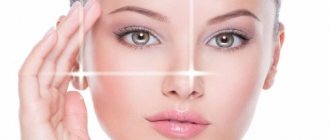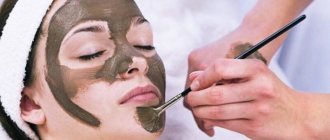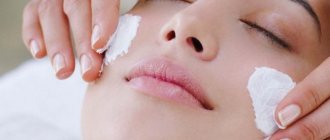The beauty of the fair sex knows no bounds. That is why girls and women use various compositions to carry out cosmetic procedures on their own, which would cost a lot of money in a salon. The leading position is occupied by peeling and its various variations, which help to achieve the desired result. This procedure is quite complicated and somewhat dangerous if all the rules and sequence are not followed. How to use peeling at home should be discussed thoroughly and in detail.
What is facial peeling and why is it needed?
Peeling is a procedure for removing the upper stratum corneum of the skin, after which the body launches restoration processes, and dead cells of our epidermis give way to new ones.
After exfoliating dead cells, the skin becomes soft, the complexion is evened out, pimples and blackheads disappear, and wrinkles are smoothed out. Peeling can lighten acne marks and scars, as well as even out skin texture. Creams, serums and various cosmetic procedures have a double effect: young cells respond better to active ingredients.
Peeling can be of several types:
- mechanical - using products with scrubbing particles;
- chemical - using acids or enzymes;
- hardware - using a special device.
Hardware cosmetology
Hardware laser peeling techniques:
- laser rejuvenation;
- ultrasonic;
- radio wave peeling.
Laser rejuvenation allows you to quickly get rid of skin defects - scars, age spots, acne, wrinkles.
This procedure is safe and effective, has virtually no contraindications or side effects, and all negative aspects are completely eliminated.
Ultrasonic peeling allows you to deeply cleanse the skin, rejuvenate it, and get rid of defects and wrinkles. Just like laser, it does not have any negative effects on the skin or the entire body as a whole - it is completely safe and most effective. Radio wave peeling is based on post-traumatic tissue restoration. This procedure is safe and does not pose any complications or side effects. After such manipulation, the skin becomes younger, deep wrinkles are smoothed out, and fine wrinkles disappear altogether.
Types of chemical peels for the face
Chemical peels can be distinguished by the depth of their penetration into the skin:
1) Superficial
Gives the most delicate exfoliation that affects the top layer of skin. During the process, as a rule, there is no unpleasant burning sensation, and afterward the skin almost does not peel off. Therefore, superficial peeling is suitable for sensitive skin and those who are just beginning their acquaintance with such procedures.
If you are unhappy with fine wrinkles, dull complexion or pimples, contact him. It is better to do it in a course - for example, four superficial peeling procedures give the same effect as one medium peeling procedure, but without side effects.
Types of superficial peeling: soft AHA acids - mandelic, glycolic, tartaric, malic; trichloroacetic acid (TCA) – 1-15%, low concentration of salicylic acid; Enzyme peeling based on the papain enzyme.
Surface peeling procedure with ARAVIA Professional products
2) Middle
Pigmentation caused by the sun, shallow scars and acne marks are indications for medium peeling, which affects not only the epidermis, but also the papillary dermis - the second layer of skin. This type of peeling requires a longer recovery period - about 14 days, but gives a more visible result in one procedure.
Types of medium peeling: 25-30% solution of trichloroacetic acid (TCA), 20% salicylic acid.
3) Deep
Penetrating deep into the skin and affecting all layers of the epidermis, deep peeling can solve serious problems - for example, smooth out deep acne scars, old scars or even out loose skin texture.
After the procedure, the skin is very flaky, itchy or even crusty - the recovery period lasts about 20 days. Deep peeling should be carried out for special indications, when the complex of superficial and middle peels can no longer cope.
Types of deep peeling: 35-50% TCA, phenol.
Contraindications (6 restrictions)
Any medical procedure may have its contraindications, and exfoliation is no exception.
First of all, it is worth noting that chemical cleansing should not be carried out on women under 50-55 years of age, since at a young age the skin is thinner and more delicate and is easily damaged.
Contraindications:
- Heart disease or installed pacemaker;
- Kidney and liver diseases;
- Oncology;
- Pregnancy and lactation;
- Eczema and psoriasis, other dermatological diseases;
- Acne, acne.
It is precisely because of possible contraindications that the patient is recommended to undergo an examination initially.
The session is not recommended for women who have dark skin, since after recovery it will become noticeably paler compared to the general background, but this is not a contraindication, but only a recommendation.
What is the difference between mono- and multi-acid peels?
Peeling can consist of either one type of acid - these are called mono-acid peels, or two or more - these are multi-acid peels. The combination of acids allows you to solve several problems at once and achieve more visible results.
You won’t be able to get a multi-acid peel by simply mixing several acids: some of them negatively affect each other and can seriously harm the skin.
That is why the selection of concentrations and working ingredients is best left to professionals. Together with dermatologists and chemist-technologists, the ARAVIA Professional brand has developed four “cocktails” of the MG Peel System, intended for both young problem skin and aging wrinkled skin. It is based on proprietary combinations of acids that provide maximum results and minimal discomfort - thanks to optimal concentration and a comfortable pH of 3.0.
Which procedure is more affordable?
What is more profitable to cleanse your face – peeling or special hardware devices? Prices for professional cleansing and chemical exfoliation vary depending on the region and the beauty clinic. The average cleaning price starts from 350 rubles and can reach 7,500 rubles. Chemical peeling will cost 2 times more – from 650 to 15,000 rubles.
Peeling in the salon or at home: pros and cons
So where should you peel: at home or in the salon? It seems to be cheaper at home, and folk remedies can be used. We explain why such a cosmetology initiative is dangerous and why it is better to trust a professional:
1) You can literally “burn” your skin
Peeling is an actual burn of the skin. The degree of this burn is regulated by a cosmetologist: he selects a solution for the skin type and strictly monitors the time of its application. Application technology is also important. Imagine how, due to the carelessness or ignorance of a novice amateur, such a serious procedure can affect the skin: it risks getting burned, and after the burn, scars or scars.
2) A cosmetologist will select an effective course
Can you determine your skin type? Maybe you think it's dry, but in fact it's dehydrated? A cosmetologist will be able to select a peeling for your skin type and its needs, create an optimal course, which may consist of peels of varying depths and strengths, and will monitor the processes of regeneration and restoration - select appropriate home care and give practical recommendations.
3) Folk remedies don’t work
“Creating” acid peeling at home is impossible. Yes, mild AHAs used in superficial peels are often obtained from fruits and berries. But strawberry puree won't actually do anything to your face.
Be careful with folk remedies. They can cause allergies Photo: user18526052 / Freepik
Indications for use
Gel peels are necessary to cleanse the skin of dead cells and impurities. At the same time, they are used if small inflammatory lesions, acne, or blackheads have formed on the skin. Peeling, dry skin appears, or, conversely, the secretion of the sebaceous glands is too increased. Fine wrinkles or age spots become noticeable. Read the article about the best creams for facial pigmentation.
How to properly peel your face: briefly
1) Peeling is best done in autumn or winter: this way, sunburn and damage to irritated skin is minimal.
2) Deep peeling is a serious procedure that requires special indications in the form of pronounced scars or scars. It is worth resorting to it in exceptional cases, but it is better to start with superficial peels - they do not cause irritation, but at the same time improve the appearance.
3) Trust a professional - he will select the type of peeling, protect you from chemical burns, give recommendations on how to prolong the effect and select home care. If you are an advanced cosmetics user, peeling can be done at home. Read the manufacturer's recommendations carefully and follow the instructions.
conclusions
Gel peels are intended primarily to cleanse the face of dead skin cells and sebum. But due to the fact that the composition contains various ingredients, they also perform another important role:
- Even out the microrelief of the skin.
- Nourishes and softens the skin.
- Eliminate post-acne and minor inflammations. And also blackheads.
- Pigment spots become less noticeable.
But before buying a cosmetic product of this type, you should determine your skin type. In addition, there are some contraindications to their use. Therefore, the choice of gel should be taken responsibly; before purchasing, read the instructions on the package.
Recipes at home
Don't want to spend money on expensive products? Or did you forget to buy a new bottle and the old one ran out? Don’t worry, cream peeling can be prepared at home.
We offer some simple ideas. Each recipe includes popular household ingredients, so they are easy to find.
- Based on aspirin. You will need: 3 aspirin, tsp. lemon juice and soda, water. Mix the first two ingredients and apply to the skin of the face. We wait only 10 minutes. Baking soda and water will be needed for rinsing. We wet a cotton pad with it and wipe it.
- For the next peeling you will need: a teaspoon of baking soda and salt, a tablespoon of face cream. Mix the listed components together. The mass should be greasy with small particles. Apply to areas prone to acne/blackheads, leave for about half an hour and rinse with plenty of cool water. It is better to apply cream after this.
- Almond peeling. Take 30-40 grams of almonds and the same amount of oatmeal. Grind and mix with a couple of tablespoons of milk. It is also worth adding tea tree oil. Let it sit for about 15 minutes until a crust forms. After this, the skin should be cleansed with plenty of warm water.
- A quick peel can be done using oatmeal. Mix a couple of tablespoons of ground cereal with water. We wait for the mixture to settle (literally 2-3 minutes), after which we rub it into the skin with massage movements. It is best to actively work on problem areas that are prone to breakouts. Then, as usual, everything is washed off with water.
- For rougher cleaning, it is recommended to mix your favorite cream with ground coffee. Grain particles are often found in professional cosmetics. They allow you to improve your facial condition.
There is nothing complicated here. Every recipe is as simple as possible. The composition can be easily prepared from improvised means, obtaining the same good effect as after a beauty salon.
When is the best time to do it?
It would seem that taking care of your beauty should be daily or at least several times a week. However, if we are talking about such a thing as facial peeling, then everything is not so arbitrary. Let's look at the season first.
It is generally accepted that only a madman would decide to peel his face in the summer. In part, there is some truth in these words. The fact is that such cleaning removes the top protective layer, that is, the skin literally becomes bare. Accordingly, active exposure to sunlight will certainly not have a positive effect on it. Ultraviolet radiation will provoke aging of the dermis, worsen its general condition, and definitely no one wants to get sunburned. Therefore, facial peeling is carried out mainly in the autumn-winter period, when the effect of ultraviolet radiation is not so active. Of course, now there are more gentle techniques, after which the skin is not so susceptible to the sun. Some manipulations can be carried out in spring and even summer. Regardless of what season you are going for the procedure, it is better to make sure you have sunscreen.
Now let's talk about age criteria. Everything is not so strict here. Peeling is available to absolutely all groups. During adolescence, it perfectly helps fight unwanted acne, which definitely does not add attractiveness. This type of cleansing is recommended for older people, as after it the skin begins to renew itself. This is a great opportunity to maintain youth without any “beauty injections.” Of course, there is no need to go to extremes. At a very young age, it is better not to use such aggressive methods.
Regarding the time of day. There are no restrictions. On the one hand, you can go in the morning, before the skin has time to pick up all sorts of dust and other impurities. If you look at it from a different angle, in the evening, after the procedure, you don’t need to go anywhere. It is enough to apply a nourishing cream and go to bed so that the epidermis gains strength overnight. In general, whatever is more convenient for you.











